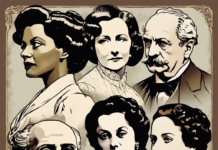
Welcome, fellow romantics and history enthusiasts, as we embark on a journey through time to unravel the fascinating tale behind the most romantic day of the year. Valentine’s Day, celebrated worldwide with hearts, flowers, and sweet sentiments, holds a rich history that transcends centuries. Let’s delve into the origins of this cherished holiday and discover the captivating story behind its enduring allure.
Origins of Love
At its core, Valentine’s Day traces its roots back to ancient Rome, where mid-February marked the celebration of Lupercalia, a fertility festival dedicated to Faunus, the Roman god of agriculture. During this festival, young men would draw names of young women from a jar, pairing them together for the duration of the festival, and sometimes even longer, igniting the spark of romance.
A Saintly Legacy
The transformation of Lupercalia into Valentine’s Day can be attributed to the influence of Christianity. In the 5th century, Pope Gelasius I combined the celebration of Lupercalia with the feast day of St. Valentine, a martyred Christian saint who lived during the 3rd century. Legend has it that St. Valentine defied Emperor Claudius II’s decree against marriage for young men, secretly officiating weddings for soldiers. This act of love and defiance ultimately led to his martyrdom, solidifying him as the patron saint of lovers.
The Age of Romance
Throughout the Middle Ages, Valentine’s Day continued to evolve, becoming increasingly associated with love and romance. Poets like Geoffrey Chaucer and William Shakespeare romanticized the holiday in their works, further cementing its status as a celebration of love. By the 18th century, exchanging handmade cards and tokens of affection became popular customs, laying the groundwork for the modern-day tradition of sending Valentine’s Day cards.
A Global Affair
Today, Valentine’s Day transcends borders and cultures, celebrated by people around the world as a day to express love and affection for those dear to their hearts. From the bustling streets of Paris, where couples lock their love on the Pont des Arts bridge, to the tranquil shores of Japan, where women shower their partners with gifts, Valentine’s Day manifests in a myriad of unique customs and traditions across the globe.
Love in the Digital Age
In the digital age, technology has revolutionized the way we express our love on Valentine’s Day. Social media platforms, messaging apps, and online gift shops provide endless opportunities to connect with loved ones and shower them with affection, even from miles away. Whether it’s a heartfelt message shared on a virtual card or a surprise delivery of flowers to their doorstep, technology has made expressing love more accessible and meaningful than ever before.
FAQs:
- What is the origin of Valentine’s Day? Valentine’s Day originated from the ancient Roman festival of Lupercalia, which was later combined with the feast day of St. Valentine, a Christian martyr who defied Emperor Claudius II’s decree against marriage for young men.
- Why is St. Valentine associated with love and romance? St. Valentine is associated with love and romance due to the legend that he secretly officiated weddings for soldiers, defying Emperor Claudius II’s ban on marriage for young men. His acts of love and martyrdom solidified him as the patron saint of lovers.
- How did Valentine’s Day evolve over time? Throughout history, Valentine’s Day evolved from a Roman fertility festival into a celebration of love and romance during the Middle Ages. It gained popularity with the exchange of handmade cards and tokens of affection in the 18th century, eventually becoming the modern-day tradition of expressing love on February 14th.
- Is Valentine’s Day celebrated globally? Yes, Valentine’s Day is celebrated globally, with customs and traditions varying from country to country. While some traditions, like exchanging cards and gifts, are universal, each culture adds its own unique flair to the celebration.
- How has technology influenced Valentine’s Day celebrations? In the digital age, technology has revolutionized the way we express love on Valentine’s Day. Social media platforms, messaging apps, and online gift shops provide convenient ways to connect with loved ones and shower them with affection, regardless of distance.
Conclusion
As we reflect on the history of Valentine’s Day, we’re reminded of the enduring power of love to transcend time and culture. From its humble origins in ancient Rome to its modern-day celebration across the globe, Valentine’s Day continues to unite us in the universal language of love. So, whether you’re exchanging heartfelt cards, sharing a romantic dinner, or simply spending time with loved ones, let’s embrace the spirit of Valentine’s Day and spread love wherever we go.










